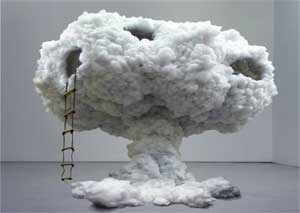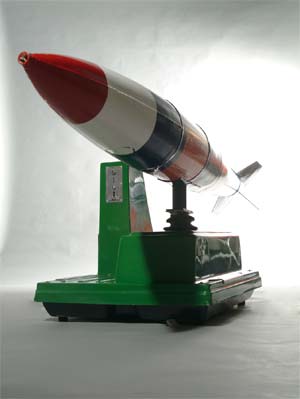Run For Your Lives!, as you might expect, is a mixture of colorful duds and time bombs. Of course, it’s difficult at this point, five years after 9/11 ushered in the present “decade of disaster,” to mount an exhibition on this subject matter that isn’t automatically rendered trite.
DiverseWorks does a respectable job of combating this unfortunate side effect. By not taking itself too seriously, the show contributes something to the subject of disasters without ruining the impact. Nevertheless, a few of the works serve as sad reminders that just because you can infuse a work of art with commentary about a devastating tragedy doesn’t mean the work is worth putting into a show.
Upon entering the gallery, I immediately notice Anitra Hamilton’s Bomb Ride . The Toronto-based artist has cleverly retrofitted a kiddy ride — the kind you spot outside the supermarket — with an authentic but defused U.S. Air Force “bomb.” The piece is whimsical, it’s colorful, and what’s more, it can actually be ridden. However, those at the opening who wished to take a little “joyride of comic dissidence” were obliged to pay one dollar. Though some may think this is cute , there is still something disconcerting about capitalizing on war-munitions-made-artwork. Please invite us to participate in your protest against the sickness of our culture, but do not charge us a buck to take part.
Next in line is Dietrich Wegner’s equally ironic, yet much less contradictory, series of humorously disturbing works. Opposite of Bomb Ride , in the corner, I find a doll-like boy with TNT strapped across his abdomen. His realistic dimensions and somber facial expression are immediately haunting, but they leave me feeling slightly perplexed. Moving quickly ahead, I discover Wegner’s huge mushroom-cloud tree house. His technique of mingling a life-sized childhood fantasy with a nuclear bomb explosion is bold without becoming Disneyland obnoxious. This kind of satire is definitely worth experiencing firsthand.
Another noteworthy artist in the show is Paula Abalos. Her huge, white, air-filled mountain, crowned with a tiny model of a plane wreck, commemorates (or commiserates with) the media-inflated issue of cannibalism that followed the infamous 1972 Andes plane crash — where rugby players were forced to eat the deceased to stay alive. Even though it’s a stationary piece, Los Andes manages to gently invade my personal space from a distance, forcing me to give it consideration. Adjacent to this, I see the work of Gabriela Trzebinski, who had the clever idea of painting canvases with television screens showing familiar disaster news clips. Unfortunately, each one is terribly underworked, and though this effect has been pulled off gracefully by artists like Luc Tuymans, Trzebinski falls short of success.
Some of the less impressive works include paintings by Katherine Taylor, who shows the aftermath of vehicle devastation, and Joy Garnett with her media-inspired depictions of unfortunate historical events. Though these works possess a certain degree of aesthetic appeal and might look wonderful in a classy studio apartment, the approach each artist has taken is hopelessly reminiscent of Andy Warhol’s disaster silk screens or Gerhard Richter’s blurry fighter jets from 1960. Other works — like Matias Duville’s charcoal wall drawing Huracan, which looks less like a hurricane than a tornado, the photographs of Lori Nix from her Accidentally Kansas series and Christoph Draeger’s print Catastrophe #1 — get largely overshadowed by the visual influence of much stronger pieces, particularly those of Wegner and Abalos. I know Nix has done better work than this, so Accidentally Kansas is a disappointment. Finally, Joe Sola’s Climaxes 1966-2001 is, quite coincidentally, very anticlimactic and might have been more appropriately given an artistically mute rubric like “Ode to Action Films.”
By far the greatest disappointment of all is the animation series by Joseph Peragine. His four digital cartoons portray now-famous images from media coverage spanning the five years since 9/11. After sitting down to watch his Yankee-doodle montage, I had to ask myself, “Haven”t we seen enough online flash-animations about political controversy?” We certainly don’t need to have more of it featured here. Aside from the ironic musical accompaniment, the works have nothing new or insightful to say about their subject matter.
Concluding with Yumi Janairo Roth and Lillian Tyrrell, I can’t help but move in for a closer look at Roth’s Domestic Tranquility towels, which are surreptitiously mounted by doorways with faux fire alarm switches. At first pass, I think the red panels and extinguisher are part of the building’s standard safety equipment. The simple embroideries on her towels parody the slogan “homeland security” and lightly mock the newfound anxiety that comes with it. Roth reminds us that terrorism is now a regular part of our national consciousness.
In a similar vein, Tyrrell’s Disaster Blanket series definitely caught me off guard. You don’t expect to see an airplane crash or a man jumping from a skyscraper depicted on handmade blankets. Although I could do without her two “preliminary sketches” (pastel on paper), the message that gets carried through her finished works is poignant. 9/11 has obviously found its way into our everyday lives — so much so that we hardly notice it anymore — but Tyrrell rightly brings our attention back to this tragic material that so permeates American existence. The work may be “crafty,” and that may be passé, but hers is obviously more than a by-product of some hipster crochet trend. Tyrrell’s art comes with a high thread count and deserves your attention.
I recommend Run For Your Lives, but I do so with a note of caution. As a whole, the show is decent, but many of the pieces are far from mind-blowing. Some disasters, it seems, are better left in the studio.
Images courtesy DiverseWorks.
Ryan Martin is a writer currently living in Houston.






